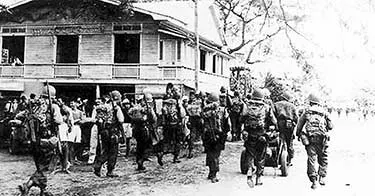The Nasugbu Landing in WWII and Its Significance to the Liberation of Batangas
Among the wartime stories that I used to hear from my late mother was the amphibious landing of American troops on the beaches of her hometown of Nasugbu in Western Batangas. I know now from my own personal research that the landing occurred on the 31st of January in 1945.
What I recall vividly from my mother’s stories was that the American troops marched on through the town where they were greeted jubilantly by the local civilian population. The Americans were so happy at the reception that they received that they gave away candies and cigarettes to bystanders.
This landing of American forces in Nasugbu, as many readers may know, has been obscured in History by the landing of more troops in Lingayen, Pangasinan. It was from Lingayen that forces of the United States would drive south through the plains of Central Luzon to subsequently liberate the capital city of Manila.
What my mother used to say was that the civilian population in Nasugbu had fled to the hills when fighting started as the Americans commenced with the landing. The evacuation was inevitable for my mother and her family, since our ancestral home was at most a kilometre and a half from the beach.
The landing was preceded by an hour of bombardment from United States Navy warships positioned offshore. Partly due to luck and partly due to planning, the American forces would land on the beaches of Nasugbu virtually unopposed.
This was because Col. Masatoshi Fujishige, upon whose shoulders the defence of the area south of Manila had been entrusted by the Shinbu Group of the Japanese Army, had placed his defences more in Tagaytay and some even closer to Batangas Bay.
This was not necessarily foolhardy since the Americans, after securing Leyte, had positioned themselves in Mindoro, an island directly to the south, as everyone knows, of Batangas Bay.
Unfortunately for him, Nasugbu itself was defended roughly by only a hundred men. This explains one question I asked my Mom which understandably she could not really answer: why the Americans were able to march through town so soon after the landing.
At least their reception by the local population is corroborated by my research: “For the most part, the amphibious landing met little resistance. When the 188th PIR (Parachute Infantry Regiment) entered the town of Nasugbu, they were met by jubilant Filipinos and tumultuous cheers.1”
One other story that my mother used to tell was that they could hear explosions “up in the mountains” on through the night after the Americans had arrived. Anyone who has been to Nasugbu knows that while the town itself is flat and coastal, it is surrounded by hills and mountains.
It is only now after research that I am discovering that the mountains my mother used to mention must have been Mt. Cariliao just east of the town and probably even Mt. Batulao on the approach to Tagaytay.
General Robert Eichelberger, commander of the American troops, wanted the entire division assembled on Tagaytay Ridge by dusk on 2 February. However, the advance of American troops was delayed by well-positioned Japanese defenders on both Mt. Cariliao and Mt. Batulao.
In the dead of the night, the sound of artillery and gun fire must have been carried on for kilometres into Nasugbu exactly as my mother had described.
Although somewhat obscured in History by the bigger landing of forces in Lingayen Gulf, the landing of American troops in Nasugbu was significant to how the war in the Philippines would eventually turn out in many ways.
For one, the presence of American troops in Nasugbu and Tagaytay kept Japanese forces south of Manila preoccupied. This, in turn, prevented them from being redeployed north to reinforce other Japanese forces which had been tasked with resisting the advance of the United States Sixth Army south to Manila from Lingayen.
After the initial hiccups in Tagaytay, American troops, reinforced by the 11th Airborne Division troops who parachuted onto the ridge, would eventually overcome Japanese defences. Once this was accomplished, the Americans could rush northwards to Manila to support the efforts of the Sixth Army.
Most significantly, or at least from the viewpoint of those of us who live in Batangas, the Nasugbu landing was the foothold from where the Americans would also launch campaigns to liberate the province.
From Nasugbu, American forces would clear the so-called Lipa Corridor. In military terms, a mobility corridor is an area through which troops and equipment can be channelled.3 American military planners considered the Lipa Corridor, which was bounded by Taal Lake to the west and by Mounts Makiling and Malepunyo to the east, vital to operations in South Luzon.
From Nasugbu, members of the 158th Regimental Combat Team would clear Batangas and Balayan Bays and also eventually gain control of the Lipa Corridor’s southern end. Meanwhile, the 11th Airborne Division would strike from the north and northeast to complete a two-pronged encirclement of the Japanese in Batangas.
The Americans would encounter fierce resistance from the Japanese at Mt. Macolod (locally known as Mt. Maculot), where most of Fujishige’s forces were concentrated. They would eventually break through and move onto Lipa, where they captured a vital airfield that would one day become Fernando Air Base.
From then on, it was a matter of time before Japanese resistance was broken; and this finally happened on the first of May at Mt. Malepunyo, a mountain that divides Lipa from San Antonio in Quezon.
2 United States Army in World War II: The War in the Pacific, Triumph in the Philippines by Robert Ross Smith
3 Mobility Corridor, Wikipedia

